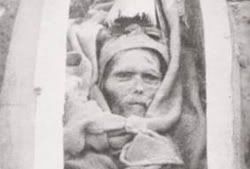Above: '1-5 Tarim Mummies - Indo-Europeans in China'; posted by alisonpita
2-5 Tarim Mummies - Indo-Europeans in China
3-5 Tarim Mummies - Indo-Europeans in China
4-5 Tarim Mummies - Indo Europeans in China
5-5 Tarim Mummies - Indo-Europeans in China
Tarim mummies (Wikipedia)
The Tarim mummies are a series of mummies discovered in the Tarim Basin in present-day Xinjiang, China, which date from 1900 BCE to 200 CE. Some of the mummies are frequently associated with the presence of the Indo-European Tocharian languages in the Tarim Basin, although the evidence is not totally conclusive. Victor H. Mair's team made the conclusion that the mummies are basically Europoid, likely speakers of an Indo-European language.
 So how would the people who were to become "the Tarim mummies" fit into this hypothesis? Well, even today--four-thousand years later--it's pretty evident that they are very Germanic-looking in appearance. Their DNA shows that they were, at that point, slightly mixed with Mongols. The bulk of the Mongols showed up in the region about three-thousand years ago. Again, the Aryan hypothesis we were looking at was long before Mongol, Semitic, or Turkic expansion.
So how would the people who were to become "the Tarim mummies" fit into this hypothesis? Well, even today--four-thousand years later--it's pretty evident that they are very Germanic-looking in appearance. Their DNA shows that they were, at that point, slightly mixed with Mongols. The bulk of the Mongols showed up in the region about three-thousand years ago. Again, the Aryan hypothesis we were looking at was long before Mongol, Semitic, or Turkic expansion.Roman accounts (Wikipedia)
Pliny the Elder (Chap XXIV 'Taprobane') reports a curious description of the Seres (in the territories of northwestern China) made by an embassy from Taprobane (Ceylon) to Emperor Claudius, saying that they "exceeded the ordinary human height, had flaxen hair, and blue eyes, and made an uncouth sort of noise by way of talking", suggesting they may be referring to the ancient Europoid populations of the Tarim Basin:
"They also informed us that the side of their island (Taprobane) which lies opposite to India is ten thousand stadia in length, and runs in a south-easterly direction—that beyond the Emodian Mountains (Himalayas) they look towards the Serve (Seres), whose acquaintance they had also made in the pursuits of commerce; that the father of Rachias (the ambassador) had frequently visited their country, and that the Seræ always came to meet them on their arrival. These people, they said, exceeded the ordinary human height, had flaxen hair, and blue eyes, and made an uncouth sort of noise by way of talking, having no language of their own for the purpose of communicating their thoughts. The rest of their information (on the Serae) was of a similar nature to that communicated by our merchants. It was to the effect that the merchandise on sale was left by them upon the opposite bank of a river on their coast, and it was then removed by the natives, if they thought proper to deal on terms of exchange. On no grounds ought luxury with greater reason to be detested by us, than if we only transport our thoughts to these scenes, and then reflect, what are its demands, to what distant spots it sends in order to satisfy them, and for how mean and how unworthy an end!"
This occurred two-thousand years ago, so apparently at least some of them were Germanic in appearance even at that point. It should be pointed out that while the Tarim mummies are constantly referenced as being "in China," it was not yet "Chinese" three-thousand years ago. Also, just because it is a desert now doesn't mean that it was a desert at the end of the last glacial movement ten-thousand years ago.

Tocharians (Wikipedia)
The Tocharians or Tokharians were ancient speakers of Tocharian languages in the Tarim Basin (modern Xinjiang, China). The Indo-European language of the Tocharians was supplanted by the Turkic languages of the Uyghur tribes about 800 AD.
The Afanasevo culture is a strong candidate for being the earliest archaeological record of speakers of the Tocharian languages.
Tocharian languages (Wikipedia)
Tocharian or Tokharian is an extinct branch of the Indo-European language family, formerly spoken in oases on the northern edge of the Tarim Basin (now part of the Xinjiang Uyghur Autonomous Region of China) by the Tocharians. Two branches of Tocharian are known from documents dating from the 3rd to 9th centuries AD:
* Tocharian A (Agnean or East Tocharian; natively ārśi) of Qarašähär (ancient Agni, Chinese Yanqi) and Turpan (ancient Turfan and Xočo); and
* Tocharian B (Kuchean or West Tocharian) of Kucha and Tocharian A sites.
 Prakrit documents from 3rd century Kroran on the southeast edge of the Tarim Basin contain loanwords and names that appear to come from another variety of Tocharian, dubbed Tocharian C. All these languages became extinct after Uyghur tribes expanded into the area.
Prakrit documents from 3rd century Kroran on the southeast edge of the Tarim Basin contain loanwords and names that appear to come from another variety of Tocharian, dubbed Tocharian C. All these languages became extinct after Uyghur tribes expanded into the area.The Proto-Indo-European Urheimat hypotheses ties closely into the "Arctic Home in the Vedas" theory, but the time frames don't quite line up, and I don't think it goes back far enough. It's too convenient. I think that Bal Gangadhar Tilak proved that this goes back further in time, and further north. The Kurgan hypothesis (see map) is the one which seems to tie in a lot of loose ends, especially in the area of the Indo-European languages, but I would still agree more with Tilak.
.

No comments:
Post a Comment